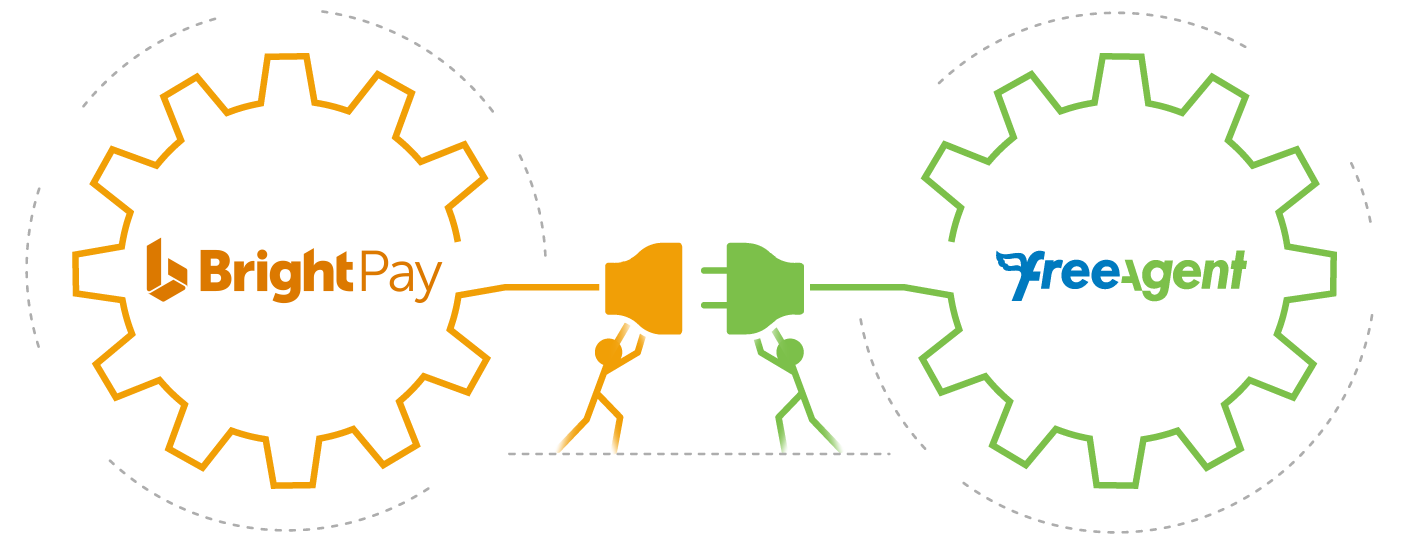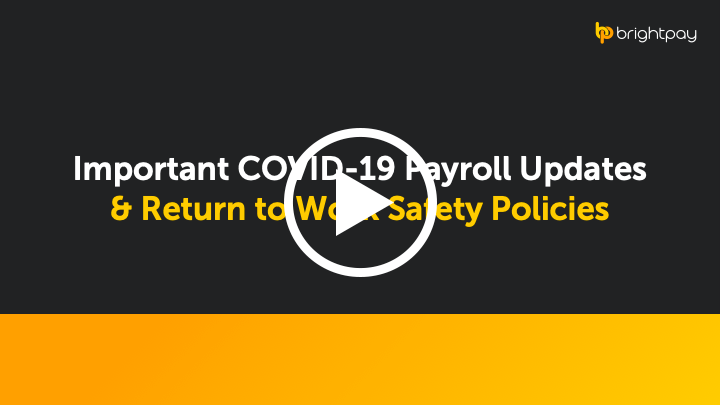Oct 2020
1
Customer Update: October 2020
Welcome to BrightPay's October update. Our most important news this month include:
-
HMRC set to crack down on furlough fraud
-
Free eBook: How to Price BrightPay Connect for your Payroll Clients
-
Kickstart Scheme opens for employer applications
-
Managing Annual Leave During COVID-19: 3 Tips Every HR Manager Needs To Know
CJRS is ending! What's in store for the months ahead?
Note: the new Job Support Scheme that was due to commence on 1 November 2020. However, the start of a second England-wide lockdown has prompted the Government to extend the existing furlough scheme until December – pushing back the start date for the Job Support Scheme
What’s in store for employers over the coming months as the Coronavirus Job Retention Scheme ends? Join us for a free webinar where we examine key concerns:
- What is the NEW Job Support Scheme?
- Can you avail of the Job Retention Bonus?
- What are the rules in relation to redundancies?
- Will remote working remain beyond 2020?
BrightPay’s Customer Satisfaction Survey – The results are in!
At BrightPay, we take customer satisfaction very seriously. We regularly carry out customer surveys to make sure our customers are satisfied with their BrightPay experience. These surveys provide invaluable information regarding what our customers want and need, and what we need to work on moving forward. We’ve compiled the results of our latest survey and we wanted to share them with you.
Furlough Changes for October
In October, the government will pay 60% of wages up to a cap of £1,875 for the hours the employee does not work. Employers will need to pay employer NI contributions and employer pension contributions plus 20% of wages to make up 80% of the total, up to a cap of £2,500. After 31st October, the government contributions will finish, and the scheme will come to an end. The new Job Support Scheme will start in November to top up the wages of employees unable to work full-time because of coronavirus restrictions over the winter.
What’s not to LOVE about BrightPay’s integration with FreeAgent
Together with FreeAgent, we’ve built a meaningful API integration to make payroll refreshingly easy while keeping your accounting simple. BrightPay produces the payroll journal in a file format that is unique to FreeAgent. Users can easily upload their payroll figures into their general ledger from within BrightPay using the FreeAgent API facility.
Redundancy and Notice Pay for Furloughed Employees
With the end of the Coronavirus Job Retention Scheme fast approaching, more employers are having to consider the issue of redundancies. New regulations which came into effect on 31 July 2020 have changed the way in which statutory redundancy and notice pay must be calculated in respect of employees who have been furloughed. If a worker loses their job and is entitled to redundancy pay, this should be calculated based on their pre-furlough wages. Firms cannot use the money from furlough to subsidise redundancy packages.
Sep 2020
16
Today marks 45 days before the end of the Furlough Scheme
The Coronavirus Job Retention Scheme will officially come to an end on 31st October 2020 and employers will need to decide to either:
- Bring their employees back to work on their normal hours
- Reduce their employees’ hours
- Terminate their employment
The government has introduced a new Job Retention Bonus Scheme, which seeks to incentivise employers to hold off on redundancies. This is a one-off payment to employers who have availed of the CJRS for each furloughed employee who remains continuously employed until 31 January 2021.
However, the unfortunate truth is if you cannot afford to pay your employees, you will need to terminate their employment. If a worker loses their job and is entitled to redundancy pay, this should be calculated based on their pre-furlough wages, and firms can't use the money from furlough to subsidise redundancy packages.
If you are making 20 or more employees redundant within any 90-day period at a single establishment, you must consult employees. This involves speaking to them about why there are redundancies being made and if there are any alternatives to redundancy.
The period of time that this consultation takes depends on how many jobs are being made redundant.
- 100 or more redundancies - the consultation must start at least 45 days before any dismissals take effect
- 20 to 99 redundancies - the consultation must start at least 30 days before any dismissals take effect
- When there are fewer than 20 redundancies, there is no set time period.
If you do not consult employees in a redundancy situation, any redundancies you make will almost certainly be unfair and you could be taken to an employment tribunal.
Today marks 45 days before the end of the furlough scheme – the deadline for large employers to commence the consultation process where 100 or more redundancies are being made. A recent study estimated that the UK was likely to see around 450,000 redundancies this autumn alone. It warned this figure could exceed 735,000 if redundancy notifications continued to rise.
Fresh calls have been made for the Coronavirus Job Retention Scheme to be extended over fears the UK could be hit with an onslaught of redundancy notices, as employers seek to comply with the 45-day notice period.
Register for our upcoming webinar to find out more about the end of the CJRS, the Job Retention Bonus Scheme and Redundancies. Places are limited – click here to book your place now.
Sep 2020
1
Customer Update: September 2020
Welcome to BrightPay's September update. Our most important news this month include:
-
Furlough wind down timescales
-
Do SEISS grants need to be paid back?
-
Thresholds to rise for Student Loan repayment from 6th April 2021
Furlough Changes for September
The Coronavirus Job Retention Scheme is ending fully on 31st October 2020, but until then, the level of the grant will be reduced each month. For September, the government will pay 70% of wages up to a cap of £2,187.50 for the hours the employee does not work. Employers will need to pay employer National Insurance contributions and employer pension contributions plus 10% of wages to make up 80% of the total, up to a cap of £2,500.
Free Webinar: CJRS & Flexible Furlough - Changes you need to know
As the government’s furlough scheme winds down in upcoming months, employers will need to contribute to employees’ wages and the Coronavirus Job Retention Scheme will end fully at the end of October 2020. In this webinar, we look at what you need to know about reduced government contributions, flexible furlough and making a claim.
Benefits of employee apps that you never knew (and why employees love them)
BrightPay Connect offers a whole host of additional features, from automatic cloud backup to employee dashboards. However, the employee app is one of the most attractive of these additional features, and for good reason. It enables you to introduce more effective ways of communicating with employees and streamline everyday processes such as annual leave requests.
Easily integrate BrightPay with your accounting software
BrightPay’s payroll journal feature allows users to create wage journals from finalised pay periods so that they can be seamlessly transferred into various accounting packages. BrightPay includes direct API integration with a number of accounting packages. With this direct integration, users will be able to directly send the payroll journal to the accounting package from within BrightPay.
Aug 2020
7
Customer Update: August 2020
Welcome to BrightPay's August update. Our most important news this month include:
-
Chancellor announces furlough bonus scheme and more in Summer Statement
-
CJRS Changes & Flexible Furlough - What you need to know
-
Flexible Furlough - Calculating Employee Hours
BrightPay Connect - What’s New?
This month saw a number of updates to BrightPay Connect, including a new option to download all payslips in a given period. The calendar functionality in BrightPay Connect has also been updated and improved, making it more user-friendly and graphically appealing for both employers and employees. Improvements such as calendar and leave view, custom leave types and requesting leave are part of the new enhancements.
Free COVID-19 & Payroll Webinar
Join BrightPay on 12th August for a free COVID-19 & Payroll webinar. In this webinar, we explore the key changes in relation to flexible furlough, phasing out of the scheme and changes to making a claim. This new flexibility will help businesses with reopening and help boost the economy. Places are limited. Click here to book your place now.
Processing Employee Hours Made Simple With BrightPay Connect
We’re always keen to hear what the biggest challenges are for payroll bureaus and how we can help make their job easier. One of the most common issues we understand is that requesting payroll information from clients can be an inefficient, time-consuming and often, frustrating process. The good news is that BrightPay Connect makes this process so much simpler. It has become a must-have tool for bureaus who want to streamline their payroll process and increase efficiency.
Automate Annual Leave Management with BrightPay Connect
After months of lockdown, many people are embracing the idea of staycations in a bid to save what’s left of the summer. For employers, however, managing employee leave can be far from relaxing if it is a manual process. BrightPay Connect’s online leave management tools eliminate cumbersome people management tasks. It’s more than just payroll software, it’s a ready-to-go, easy-to-use HR software solution. The staycation trend should be a reason to be excited, not an admin nightmare.
Jul 2020
3
Flexible Furlough - Employees Returning to Work Part-Time
The Coronavirus Job Retention Scheme is changing to support businesses as the economy is carefully reopened. Before July, employees that were placed on furlough could not undertake work for you. Originally, the scheme was only for employees who were not working, and while on furlough, an employee could not undertake work for or on behalf of the organisation.
From 1st July, businesses have the flexibility to bring furloughed employees back to work for any amount of time and any shift pattern, while still being able to claim under the CJRS for hours not worked. This new flexibility will help businesses with reopening and help boost the economy.
The government will continue to pay 80% of furloughed employees wages for any normal hours they do not work, up until the end of August, but the employer will have to pay employees for the hours they do work. For example, if a furloughed worker returns to work for two days per week, they would need to be paid as normal by their employer for these two days, while the government would cover the other three days.
Employers will decide the hours and shift patterns their employees will work on their return, and so employees can work as much or as little as the business needs, with no minimum time that they can furlough staff for.
Any working hours arrangement agreed between a business and their employee must cover at least one week and be confirmed to the employee in writing. You must keep a written record of the agreement for five years and keep records of how many hours your employees work and the number of hours they are furloughed (i.e. not working).
If employees are unable to return to work, or employers do not have work for them to do, they can remain fully furloughed and the employer can continue to claim the grant for their full hours under the existing rules.
From 1st July, employers will only be able to claim for employees who have previously been furloughed for at least 3 consecutive weeks any time between 1st March 2020 and 30th June 2020. An exception to this is where an employee is returning from statutory parental leave after 10th June and meets the qualifying criteria to be furloughed for the first time.
Where an employee is flexibly furloughed, employers will be required to submit data on the usual hours an employee would be expected to work in a claim period, the employee’s actual hours worked, and the number of furloughed hours for each claim period.
If you claim in advance and your employee works for more hours than you agreed, then you’ll have to pay some of the grant back to HMRC. This means that you should not claim until you have certainty about the number of hours your employees are working during the claim period.
Interested in finding out more about the new changes to the Coronavirus Job Retention Scheme? Watch our webinar on-demand where we discuss flexible furlough, the wind-down of the scheme and changes to making a CJRS claim.
Jul 2020
2
Customer Update: July 2020
Welcome to BrightPay's July update. Our most important news this month include:
-
Timeline - Furlough scheme to wind-down gradually
-
Flexible Furlough - Employees Returning to Work Part-Time
-
Chancellor to grant “draconian” powers to reclaim millions in Covid-19 support payments
-
Calculating a flexibly furloughed employee's 'usual hours'
Changes to the CJRS & Furloughing Employees
The Coronavirus Job Retention Scheme has been hugely popular and will continue to support jobs until the end of October. However, from 1st July, there will be many changes to the scheme. Here we've put together a summary of some of the key points in relation to flexible furlough, phasing out of the scheme and changes to making a claim.
Employees returning from statutory leave after 10 June 2020
From 1st July 2020, employers will only be able to claim for employees who have previously been furloughed for at least 3 consecutive weeks any time between 1st March 2020 and 30th June 2020. An exception to this is where an employee is returning from statutory parental leave after 10th June 2020 and meets the qualifying criteria to be furloughed for the first time.
CJRS calculations have changed in BrightPay from version 20.5 onwards
For many of our customers, this calculation change will not make a difference. But those who pay in lieu (e.g. a July pay date for June payroll), or those for whom an already submitted claim period ending 30 June did not actually cover all of June's earnings, will need to check and ensure that all reclaimable amounts are accounted for and submitted to HMRC prior to making July claims.
COVID-19 Webinar - Did you miss it? Watch on-demand now
During our most recent webinar, we looked at upcoming changes to the Coronavirus Job Retention Scheme. We also examined five principles that employers should be following to protect employees as they come back to work. Don't miss out - watch it back anytime.
Jun 2020
30
CJRS 2.0 - What you need to know
The Coronavirus Job Retention Scheme has been hugely popular and, according to recent statistics, over 1.1 million employers had furloughed employees in 9.2 million jobs and claimed more than £23 billion in grants. The CJRS scheme will continue to support jobs until the end of October, however, from 1st July, there will be many changes to the scheme. Here we've put together a summary of some of the key points to note.
Flexible Furlough
To date, employees that were placed on furlough could not undertake work for you. Originally, the scheme was only for employees who were not working, and while on furlough, an employee could not undertake work for or on behalf of the organisation. However, from 1st July, employers will be able to bring furloughed workers back to work on a part-time basis while still being able to claim under the CJRS for hours not worked.
- The government will continue to pay 80% of furloughed employees wages for any normal hours they do not work, up until the end of August, but the employer will have to pay employees for the hours they do work, e.g. if a furloughed worker returns to work for two days per week, they would need to be paid as normal by their employer for these two days, while the government would cover the other three days.
- From 1st July, employers will only be able to claim for employees who have previously been furloughed for at least 3 consecutive weeks any time between 1st March 2020 and 30th June 2020. An exception to this is where an employee is returning from statutory parental leave after 10th June 2020 and meets the qualifying criteria to be furloughed for the first time.
- Employers will decide the hours and shift patterns their employees will work on their return, and so employees can work as much or as little as the business needs, with no minimum time that they can furlough staff for.
- If employees are unable to return to work, or employers do not have work for them to do, they can remain fully furloughed and the employer can continue to claim the grant for their full hours under the existing rules.
Furlough Scheme Wind-Down
From August 2020, the level of grant will be reduced each month. Employers will have to start contributing to the wage costs of paying their furloughed staff, and this employer contribution will gradually increase in September and October.
- In August, the government will continue to pay 80% of wages up to a cap of £2,500, but employers will be required to pay employer National Insurance contributions and employer pension contributions. For the average claim, this represents 5% of the gross employment costs that they would have incurred if the employee had not been furloughed.
- For September, the government will pay 70% of wages up to a cap of £2,187.50 for the hours the employee does not work. Employers will need to pay employer NI contributions and employer pension contributions plus 10% of wages to make up 80% of the total, up to a cap of £2,500.
- In October, the government will pay 60% of wages up to a cap of £1,875 for the hours the employee does not work. Employers will need to pay employer NI contributions and employer pension contributions plus 20% of wages to make up 80% of the total, up to a cap of £2,500.
- After 31st October, the government contributions will finish and the scheme will come to an end.
Making a Claim
In line with the above changes to the Coronavirus Job Retention Scheme, there are also changes to the way employers need to make a claim.
- Employers will have until 31st July to make any claims in respect of the period to 30th June. Claims for periods after 30th June can only be made from 1st July.
- Claim periods starting on or after 1st July 2020 must start and end within the same calendar month. Therefore, pay periods which span two calendar months must be broken down into two separate claims. This is to accommodate the fact that the scheme is changing from month to month.
- It is possible to make more than one claim in each month, but each claim must be for a minimum period of at least 7 days. The only exception to this is if you are claiming for the first few days or the last few days in a month, known as 'orphan days'. In this instance, a claim period can be shorter than 7 days.
- The number of employees you can claim for in any claim period from 1st July 2020 cannot exceed the maximum number of employees you claimed for in any single claim before 30th June 2020. An exception to this is where an employee is returning from statutory parental leave after 10th June.
- When claiming for employees who are flexibly furloughed, employers are required to submit data on the usual hours an employee would be expected to work in a claim period and actual hours worked. Therefore, you should not claim until you are sure of the exact number of hours they will have worked during the claim period.
Interested in finding out more about the new changes to the Coronavirus Job Retention Scheme? Watch our webinar on-demand where we discuss flexible furlough, the wind-down of the scheme and changes to making a CJRS claim.
Jun 2020
4
The Road to COVID-19 Recovery - Return to Work Safety Policies
Join us on 11th June for a free COVID-19 webinar
This webinar will examine key facts & updated guidance on COVID-19 payroll impacts. Understand what the lockdown easing will mean for your business as you reopen and what COVID-19 safety policies you need to introduce.
Part 1: Important COVID-19 Payroll Updates
In recent months, HMRC have introduced COVID-19 Government schemes to help keep paying employees with a number of important updates being rolled out. The government has announced the first steps to ease the coronavirus restrictions with a roadmap in place for lockdown measures to be slowly lifted. Understand how to adapt your payroll processes to accommodate for the schemes and subsequent updates.
Agenda
- The Coronavirus Job Retention Scheme - A Quick Recap
- How BrightPay’s CJRS Claim Report works
- COVID-19 Related Statutory Sick Pay & The SSP Rebate Scheme
- Managing Annual Leave during COVID-19
Part 2: Return to Work Safely Protocol
The UK government has set out a roadmap for lifting further restrictions and opening more businesses and venues, but this plan is dependent on successfully controlling the spread of the virus. Employers should stay safe in public spaces and workplaces by following 'COVID-19 secure' guidelines.
With the emergence from lockdown becoming clearer, businesses will need to start to put plans and COVID-19 policies in place for their employees to go back to the workplace safely. It is advisable for all workplaces to adapt their workplace HR policies, procedures and practices to comply with the COVID-19 related safety guidelines.
Unable to attend?
If you are unable to attend the webinar at the specified time, simply register for the webinar anyway and we will send you the recording afterwards. You can also click here to view more webinar dates.
May 2020
8
Thank you for your wonderful comments!
The BrightPay team have received lots of words of praise and thanks over the past few weeks. Here's a selection of some of the wonderful comments that have been sent in. We would like to thank everyone for their positive feedback, your kind words are very much appreciated and encourage us to keep going during in these challenging times.
Thank you. Stay Safe.
Apr 2020
21
Coronavirus Job Retention Scheme: Which employees are eligible?
The Coronavirus Job Retention Scheme is a temporary scheme open to all UK employers for four months starting from 1 March 2020. It is designed to support employers whose operations have been severely affected by COVID-19.
If you have any employees who have been placed on a leave of absence, they would be considered a furloughed employee. Employers can claim for 80% of furloughed employees’ usual monthly wage cost, up to £2,500 a month, plus the associated Employer NI contributions and minimum automatic enrolment employer pension contributions on that wage.
All UK companies are eligible: limited companies, sole traders who employ people, LLPs, partnerships, and charities. Employers can use this scheme anytime during this period. Claims can be backdated until the 1 March if applicable, and grants will be prorated if your employee is only furloughed for part of a pay period.
Which employees are eligible?
Prior to now, furloughed employees must have been on your PAYE payroll on 28 February 2020, but this has now been extended to 19th March. This brings into scope a large number of people who fell outside the scheme because they had recently changed jobs.
It’s available to all employees on a contract, including:
- full-time employees
- part-time employees
- employees on agency contracts
- employees on flexible or zero-hour contracts
You can claim for employees that were employed as of 19 March 2020 and were on your PAYE payroll on or before that date; this means that you will have made an RTI submission notifying HMRC of a payment to that employee on or before 19 March 2020. For employees that were employed as of 28 February 2020 and on payroll (i.e. an RTI submission was sent to HMRC) and were made redundant or stopped working for you after that, and before 19 March, they can also qualify for the scheme if you re-employ them and put them on furlough.
A business may need to furlough all employees if it has temporarily closed down, as in hospitality or non-food retail. However, you do not need to place all your employees on furlough. You can choose to furlough a group of employees, whilst key workers continue to work, or to rotate groups between furloughing and working.
However, those employees who you do place on furlough cannot undertake work for you. This scheme is only for employees who are not working. While on furlough, an employee cannot undertake work for or on behalf of the organisation, but if their contract of employment permits, they may take on new employment with an alternative employer whilst on furlough.
Even if an employee is working, but on reduced hours, or for reduced pay, again, they will not be eligible for this scheme and you will have to continue paying the employee through your payroll and pay their salary subject to the terms of their employment contract.
- If an employee is on unpaid leave, they cannot be furloughed, unless they were placed on unpaid leave after 28 February.
- If an employee has more than one job they can be furloughed for each job. Each job is separate, and the cap applies to each employer individually. Employees can be furloughed in one job and receive a furloughed payment but continue working for another employer and receive their normal wages.
- If an employee is on or plans to take maternity leave, the normal rules apply, and they are entitled to claim SMP. The same applies if the employee qualifies for adoption, paternity or shared parental pay.
- Employees who are unable to work because they have caring responsibilities resulting from COVID-19, for example, employees that need to look after children, can be furloughed.
When calculating claim values for directors of owner-managed companies you can only consider the salary that has been subject to PAYE, not any dividends paid to those directors. They are essentially furloughing themselves, and the understanding is that they do no income-generating work for their business while on furlough, but they can continue to run the business from a statutory perspective, for example preparing their accounts and returns. This also applies to salaried individuals who are directors of their own personal service company (PSC).
Furlough Pay or SSP?
You can claim back from both the Coronavirus Job Retention Scheme and the SSP rebate scheme for the same employee but not for the same period of time. When an employee is on furlough, you can only reclaim expenditure through the Coronavirus Job Retention Scheme, and not the SSP rebate scheme. Likewise, if a non-furloughed employee becomes ill, or needs to self-isolate or shield themselves, then you might qualify for the SSP rebate scheme, enabling you to claim up to two weeks of SSP per employee.
Furloughed employees retain their statutory rights, including their right to Statutory Sick Pay. This means that furloughed employees who become ill must be paid at least Statutory Sick Pay (subject to them meeting the eligibility criteria). It’s up to the employer to decide whether to move these employees onto SSP or to keep them on furlough, at their furloughed rate.
- If a furloughed employee who becomes sick and is moved onto SSP, employers can no longer claim for the furloughed salary. Employers are required to pay SSP themselves, although they may qualify for a rebate for up to 2 weeks of SSP.
- If employers keep the sick furloughed employee on the furloughed rate, they remain eligible to claim for these costs through the furloughed scheme.
If an employee has a condition which makes them extremely vulnerable and received a letter from the NHS, they are strongly advised to shield themselves. Shielding is in place to protect extremely vulnerable people from coming into contact with coronavirus. Employers can claim for furloughed employees who are shielding, if they are unable to work from home and you would otherwise have to make them redundant. This also applies to those who need to stay home with someone who is shielding.
Furlough Periods
An employee can be furloughed for a minimum period of three consecutive weeks. When they return to work, they must be taken off furlough. Employees can be furloughed multiple times, but each separate instance must be for a minimum period of 3 consecutive weeks.
The scheme was originally available for a maximum of three months from 1 March, but this has since been extended to four months. The individual could remain furloughed even after the scheme ends, but in this instance, the employer would not have any grant funding to cover their wages. Depending on your circumstances, it may be necessary to consider termination of employment (redundancy). Grants cannot be used to substitute redundancy payments.
Join BrightPay for a free COVID-19 webinar where we discuss what you need to know about remote working, processing SSP, the Coronavirus Job Retention Scheme and placing employees on furlough leave. Places are limited - Click here to book your place now.















